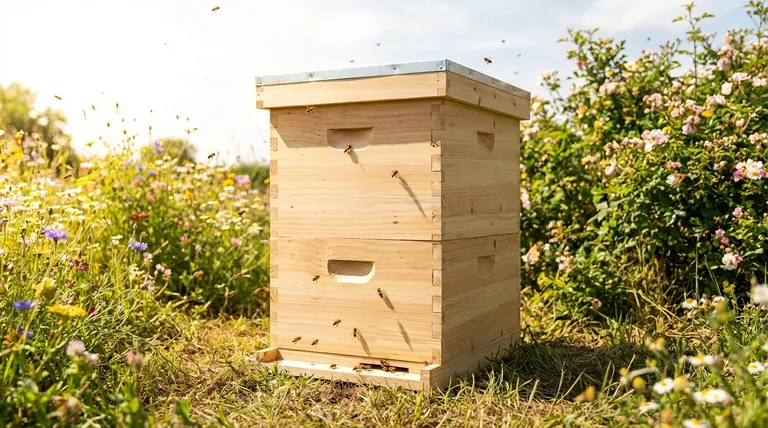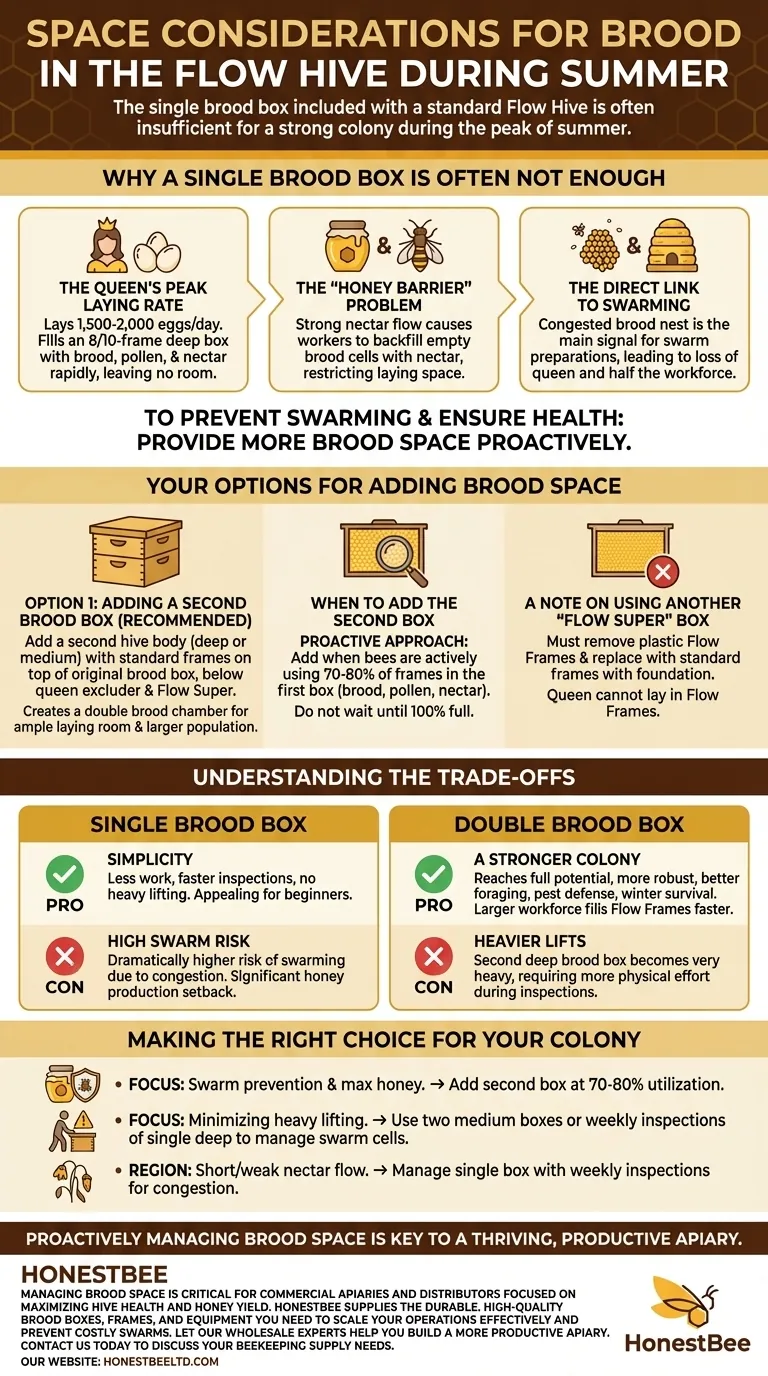In short, the single brood box included with a standard Flow Hive is often insufficient for a strong colony during the peak of summer. A prolific queen and a strong nectar flow can quickly lead to a congested hive, which is the primary trigger for the colony to swarm.
While the Flow Hive simplifies honey extraction, it does not alter the fundamental biology of bees. A thriving colony's need for brood space in summer will almost always exceed a single box, making proactive space management critical to prevent swarming and ensure hive health.

Why a Single Brood Box Is Often Not Enough
Understanding the population dynamics inside the hive during summer is key. The colony is at its peak, and its primary biological driver is expansion.
The Queen's Peak Laying Rate
During the height of the season, a healthy queen can lay between 1,500 and 2,000 eggs per day. A single 8-frame or 10-frame deep box can fill up with brood, pollen, and nectar surprisingly fast, leaving her with no room to lay.
The "Honey Barrier" Problem
When a strong nectar flow is on, worker bees are programmed to store it wherever they can. If the honey super is full or not yet accessible, they will begin to backfill empty cells in the brood nest with nectar, creating a "honey barrier" that further restricts the queen's laying space.
The Direct Link to Swarming
A congested brood nest is the most significant signal for a colony to begin swarm preparations. The bees perceive they have run out of room for the queen to lay and for the population to expand, so they will create queen cells to raise a new queen and prepare for the old queen to leave with up to half the workforce.
Your Options for Adding Brood Space
To prevent swarming and maintain a strong, productive colony, you must provide more space for the brood nest before it becomes congested.
Option 1: Adding a Second Brood Box
This is the standard and most recommended method in beekeeping. You add a second hive body (a "deep" or "medium" box) filled with standard frames on top of your original brood box, but underneath the queen excluder and Flow Super.
This creates a double brood chamber, giving the queen ample room to lay and allowing the colony to build up a much larger population. A larger workforce ultimately means more foragers to fill the Flow Frames.
When to Add the Second Box
The key is to be proactive. When you inspect your hive and find that the bees are actively using 70-80% of the frames in the first brood box (with brood, pollen, or nectar), it is time to add the second box. Do not wait until it is 100% full.
A Note on Using Another "Flow Super"
While you can technically use the box from a Flow Super, you must remove the plastic Flow Frames and replace them with standard wooden or plastic frames with foundation. The queen cannot lay eggs in the Flow Frames. This can be an expensive way to create a brood box but is a viable option if you have a spare.
Understanding the Trade-offs
Managing brood space involves balancing hive health against the beekeeper's convenience.
The Pro of a Single Brood Box: Simplicity
Managing a single brood box is less work. Inspections are faster, and there is no heavy lifting of a second deep box full of brood and honey. This is why it is an appealing setup for beginners.
The Con of a Single Brood Box: High Swarm Risk
The simplicity comes at a high price. The risk of the hive swarming due to congestion is dramatically higher. Losing a swarm means losing your queen and half your bees, which severely sets back honey production for the season.
The Pro of a Double Brood Box: A Stronger Colony
Providing adequate brood space allows the colony to reach its full population potential. This creates a more robust, resilient hive that can forage more effectively, defend against pests, and better survive winter. A larger workforce will fill your Flow Frames faster.
The Con of a Double Brood Box: Heavier Lifts
The primary downside is operational. A second deep brood box can become very heavy, requiring more physical effort during inspections. This is a significant consideration for beekeepers with physical limitations.
Making the Right Choice for Your Colony
Your decision should be guided by the primary goal you have for your hive and your local conditions.
- If your primary focus is swarm prevention and maximum honey production: Add a second brood box as soon as the first box is 70-80% utilized.
- If your primary focus is minimizing heavy lifting: Use two medium boxes for your brood chamber instead of two deeps, or commit to weekly inspections of a single deep to manage swarm cells aggressively.
- If you are in a region with a very short or weak nectar flow: You may be able to manage with a single brood box, but you must remain vigilant and inspect for signs of congestion weekly during the peak season.
Proactively managing brood space is the key to transforming your Flow Hive from a simple honey collector into a thriving, productive apiary.
Summary Table:
| Option | Pro | Con |
|---|---|---|
| Single Brood Box | Simpler, faster inspections | High risk of swarming, limits colony size |
| Double Brood Box | Stronger colony, more honey, prevents swarming | Heavier to lift during inspections |
| Add when first box is 70-80% full | Proactive swarm prevention | Requires regular monitoring |
Ensure your Flow Hive colony thrives this summer.
Managing brood space is critical for commercial apiaries and distributors focused on maximizing hive health and honey yield. HONESTBEE supplies the durable, high-quality brood boxes, frames, and equipment you need to scale your operations effectively and prevent costly swarms.
Let our wholesale experts help you build a more productive apiary. Contact us today to discuss your beekeeping supply needs.
Visual Guide

Related Products
- Langstroth Bee Hives Bee Keeping Box for Beginners Beekeeping
- Honey Flow Garden Bee Hive Flow Hive Best Beehive for Beginners
- 7 x Auto Bee Flow Hive Frames Plastic Beekeeping Hive Box Supplies
- HONESTBEE Advanced Ergonomic Stainless Steel Hive Tool for Beekeeping
- Wholesales Dadant Size Wooden Bee Hives for Beekeeping
People Also Ask
- Why were wooden hives traditionally preferred? For Natural Beekeeping Aligned with Bee Biology
- Should a beginner try a different type of hive? Start with a Langstroth for a solid foundation.
- What is the best type of bee hive for beginners? Start with the Proven Langstroth Standard
- How does the orientation of the hive sides benefit comb construction? Ensure Straight, Movable Combs for Easier Hive Management
- What basic equipment is needed to start beekeeping? Your Essential Guide to a Confident Start



















